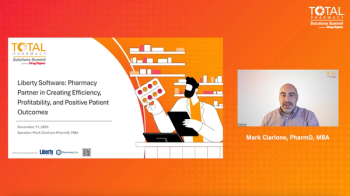
The Redefinition of Pharmacy Jobs
Some jobs may disappear while others evolve and require further training.
Predicting which pharmacy jobs will still be around in five or fifteen years isn’t easy because the future is not what it used to be. The accelerating pace of change in the healthcare industry would have been difficult to imagine even a decade ago.
From mergers and acquisitions potentially reshaping pharmacy concepts, to expanded prescribing possibilities and the increasing presence of telepharmacy, some jobs may indeed disappear, while others evolve or prompt pharmacists to seek further training.
“Existing technologies such as central-fill and robotics will replace the active involvement of the pharmacist with each prescription,” says Anderson. “There will be an increasing use of technicians to be responsible for the dispensing and inventory functions-this includes checking the final product. We may see the concept of the assistant pharmacist reappear-phased out in the 1950s-as exists in many European countries.”
Trending:
Many pharmacists will be challenged to redefine their careers in the absence of traditional dispensing responsibilities. “That means determining and augmenting one’s particular skills and identifying a customer for those skills,” says Anderson.
Healthcare Team Members
One role that is projected to increase is for pharmacists to become members of a healthcare team. For years, pharmacists have been employed to increase the efficiency of healthcare in hospital settings, and similar care models are being developed that may use pharmacists to coordinate medication in other care environments.
“At the moment, community pharmacists may not be practicing at the top of their profession,” says
By managing medication use, as part of a team, pharmacists can help increase safety, efficiency, and cost. Pharmacists are well-positioned to identify gaps in medication adherence and are knowledgeable about cost-effective medication solutions.
One development that is making it easier for pharmacists to participate in healthcare teams is networks of community pharmacies that provide enhanced clinical services, like CPESN, which coordinates patient care with broader care teams. Networks have formed in 32 states, and are inviting independent pharmacists to offer pharmacy services as part of a team.
“That’s a change that’s a great opportunity for pharmacists to get involved with patients,” says
Continue reading on page 2...More Services
Both chain and independent pharmacies are evolving to offer more services, which may include a wider range of immunizations and/or long-term management for conditions such as diabetes. All 50 states now let pharmacists provide immunizations, and in some states, pharmacists can also prescribe naloxone, contraceptives, epinephrine, and some travel medications.
“Pharmacists are already giving vaccines,” says Dominelli. “Some take the next step. Some pharmacists set up a whole business dispensing long-acting antipsychotic injectables, so folks don’t have to receive their medication from a doctor. That’s a whole new opportunity that will only expand as more and more specialty drugs come out,” she says.
“There’s also more of a need for prior authorization and there are some really savvy pharmacists who set up their own prior-authorization business. They hired pharmacists and pharmacist technicians and are going to doctors, saying, ‘We know this paperwork is cumbersome, so why not contract with us? We’ll take care of this for you,’ ” she says. These pharmacists saw an opportunity and were on it.
Regularly assessing a community’s needs and envisioning new ways to fulfill those needs is an essential business model for independent pharmacies. That means keeping up on new medical trends to potentially incorporate and capitalize on.
“There’s a mental health first aid [course], a day-long program, that some pharmacy owners are sending staff members to, so they can better assist patients already identified with mental health issues, but also help identify patients who haven’t yet been diagnosed,” said
Read More:
Recent mergers and acquisitions may also lead to new roles for pharmacists in managing long-term medical conditions. The merger of CVS Health and Aetna may create new healthcare models requiring a pharmacist’s involvement, says Dominelli.
“They are piloting designs that provide patients with new services to help manage long-term conditions,” she says. “Some of those services may be provided by pharmacists and some by nurse practitioners. There will be an opportunity there for pharmacists to work in an interdisciplinary mode, to work in ways they haven’t done before. They are piloting certain care programs for people with cardiac conditions and people with diabetes that provide an opportunity for pharmacists to get out from behind the counter and closer to patients.”
Proposed legislation in Congress may increase the ways to reimburse pharmacists for more services. If passed, the Pharmacy and Medically Underserved Areas Enhancement Act (S 109 and HR 592) means that beneficiaries in medically underserved communities could get Medicaid and Medicare Part B services from a pharmacist who would be paid for providing the services. Such reimbursement would not only protect existing pharmacy jobs but potentially create some, as well as filling a need for healthcare in many communities.
Continue reading on page 3...According to Hoey, one way to ensure that pharmacy remains a profitable profession is to not accept the status quo and to look for opportunities to fill healthcare gaps in society.
“Whether it’s in consulting in the pediatric ICU or in a long-term convalescence home, there is always a role for someone who is a problem solver, a critical thinker, and a great communicator,” said Hoey. “The same is true for community pharmacists. You have to go into it not assuming that role is necessarily going to be there in fifteen years. You have to be willing to be among the people pushing a law forward to proactively come up with a model where pharmacists get paid for active review of medications.”
Drug Research
Research will continue to require pharmacists. “There’s plenty of opportunity,” says Dominelli. “New drugs coming out are more complex than earlier modalities and need more pharmacological vigilance. We need more people to look into drug safety, so pharmacist-involved clinical trials will still go on. Pharmacists are well positioned to evolve along with the changes, as long as they stay on top of swiftly changing trends. Changes will have an impact on pharmacy practice, but if you’re sharp, you can see wonderful opportunities in that change.”
Trending:
Anderson advises pharmacy school students to look outside of contemporary pharmacy practice, to discover which industries may benefit from their expertise.
“Direct patient care is important and rewarding, but there are so many opportunities that build on experiences in patient care,” says Anderson. “The experience of ‘caring for’ is the foundation for any health-care provider and should be incorporated into one’s personal brand.”
Newsletter
Pharmacy practice is always changing. Stay ahead of the curve with the Drug Topics newsletter and get the latest drug information, industry trends, and patient care tips.











































































































































































































